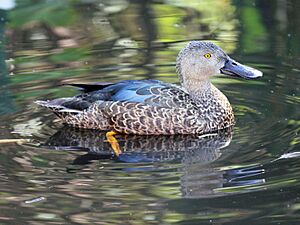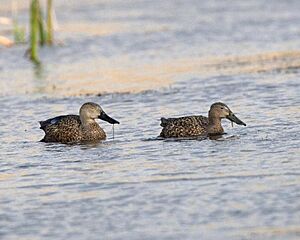Cape shoveler facts for kids
Quick facts for kids Cape shoveler |
|
|---|---|
 |
|
| Male | |
 |
|
| Female | |
| Conservation status | |
| Scientific classification | |
| Genus: |
Spatula
|
| Species: |
smithii
|
| Synonyms | |
|
Anas smithii (Hartert, 1891) |
|
The Cape shoveler (Spatula smithii) is a special type of duck found mainly in South Africa. You can also find them in other southern African countries like Namibia, Botswana, and Zimbabwe. These ducks are about 51 to 53 centimeters (20-21 inches) long.
Unlike some birds, Cape shovelers do not fly long distances for winter. They stay in their home areas all year. When they are not busy raising their young, they like to hang out together in big groups.
Contents
What Does a Cape Shoveler Look Like?
The Cape shoveler has a very unique bill that looks like a large spoon. This special bill helps them find food!
Colors and Markings
Adult Cape shovelers have feathers that are speckled grey-brown. Their legs are a dull orange color. It can be a bit tricky to tell the boys (males) and girls (females) apart because they look quite similar.
- Male Shovelers: The male has a slightly lighter head than the female. His front wing feathers are a light blue color. There's a white line that separates this blue from a bright green patch on his wing. He also has bright yellow eyes.
- Female Shovelers: The female's front wing feathers are grey.
If you ever see a duck that looks like a Cape shoveler but is much darker and a bit chunkier, it might be a different kind of shoveler called a northern shoveler. However, the Cape shoveler is usually easy to spot because of its unique look.
Where Do Cape Shovelers Live?
Cape shovelers love to live in open wetland areas. These are places like wet grasslands or marshes. They especially like areas that have some plants growing out of the water.
Favorite Foods
These ducks are called "dabbling ducks" because of how they eat. They often swing their big, spoon-shaped bills from side to side in the water. This helps them strain out tiny plants and seeds. During the time when they are raising their babies, they also enjoy eating small snails and insects.
Building a Nest
When it's time to lay eggs, the female Cape shoveler makes a simple nest on the ground. It's usually a shallow dip lined with soft plant material and down feathers. They like to build their nests close to water for safety and easy access to food.
Sounds They Make
Cape shovelers are generally quiet birds.
- Male Calls: The male makes sounds like "rarr" and "cawick."
- Female Calls: The female has a more typical "quack" sound.
Discovering the Cape Shoveler
The Cape shoveler was first officially described in 1891. A German bird expert named Ernst Hartert gave it its scientific name, Spatula smithii. The "smithii" part of its name is a tribute to a Scottish zoologist named Andrew Smith.
Conservation Status
The Cape shoveler is doing well in the wild. The IUCN Red List, which tracks how many animals are left, says that the Cape shoveler is a species of "least concern." This means there are plenty of them around, and they are not currently in danger.


